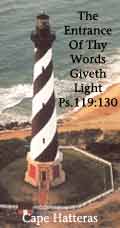
Dedicated To The Men of God Who Preach the Word of God As It
Is To Men As They Are

Introduction:
Moses is the greatest character in the Old Testament. David is the greatest king. Joseph is the greatest personal type of Jesus in the
Bible. Moses was a statesman, lawgiver, poet, songwriter, deliverer and a type of Christ. When God appeared to Moses in Chapter 3:1-6 of the Book of Exodus, we see him at the burning bush. That burning bush has a threefold significance:1. It was a picture of God in that it revealed His glory and power. (Deuteronomy 33:16)
2. It was symbolic of the national of Israel going through the fires of affliction, yet not being consumed.
3.
It was a picture of Moses himself. I. Moses as a Type of Christ.A. Moses was extraordinary in infancy. (Exodus 2:2; Luke 2:40)
B. While in infancy, attempts were made on his life.
(Exodus 1:22; Matthew 2:13)C. Moses was a chosen deliverer. (Exodus 3:10; Acts 7:34-35;
Luke 4:18; I Thessalonians 1:10; II Corinthians 1:10)D. Moses was a prophet. (Deuteronomy 18:15; John 6:14)
E. Moses was a priest. (Psalm
99:6; Hebrews 7:23-2 7)F. Moses, like Jesus, was a king. (Deuteronomy 18:15; Acts 3:22-26; Deuteronomy 33:4-5; Matthew 2:2 and 2 7:29; Acts 1 7
G. Moses, like Jesus, was a shepherd. (Exodus 3:1; John 10:11; Hebrews 13:20; I Peter 5:4)
H. Moses and Jesus were mediators. (Exodus 33:8; I Timothy 2:5)
I. Both were intercessors. (Numbers 21:7; Romans 8:34)
J.
Jesus and Moses refused the glory of the Kingdoms. (Hebrews 11:24-27; Matthew 4:8-10)K. Both were rich, but became poor for the sake of others. (Hebrews 11:26; II Corinthians 8:9)
L. Both were called out of Egypt. (Hebrews 11:27; Matthew 2:15)
M. Moses and Jesus were rejected by men, but exalted by God.
(Acts 7:35; Matthew 8:26-27)N. Moses and Jesus provided water to the thirsty. (Exodus 17:6;
John 7:37)0. Moses and Jesus became advocates for their people.
(Numbers 27:5; I John 2:1)P. Both Moses and Jesus had transfigured faces. (Exodus 34:29; Matthew 17:1-2)
Q.
Both called 70 men for special services. (Numbers 11:16-17; Luke 10:1)R. Both are connected with the blood covenant. (Exodus 24:8; Luke 22:20)
S. Both are connected with a midnight cry. (Exodus 11:6; Matthew 25:6)
T. Both received a Gentile Bride. (Exodus 2:21;
Ephesians 4:29-32)U. Both obtained pardon for others. (Numbers 14:17; Ephesians 4:32)
II. ZipporahA. Meaning of her name.
1. The root word is an Arabic verb.
2. Means to chirp; bird; sparrow.
B. Zipporah, the Midianite was one of seven daughters.
1. Her father
's name was Jethro, who is also called Reuel and Raguel (Exodus 2:18; 4:18; 18:1-6; Numbers 10:29)a. Eldest of the Seven.
C. Midianites: Descendants of the eldest son of Abraham and Keturah.
D. Moses came to her father, the shepherd priest in Midian, when he was 40 years of age.
1. Moses saw seven girls drawing water and he helped them.
E. She had Two Sons.
1. Gershom: Alien in a strange land; or stranger.
2. Eliezer: God the helper; the Lord was my help.
a. The name Eliezer is first mentioned in Exodus 18:4.
F. Zipporah did not share the spiritual values of Moses.
1. Moses acted against the sacred tradition of Israel.
2. Moses was stricken with a mortal disease.
3. He compromised with an unbelieving wife.
G. Circumcision was a covenant symbol between God and His people.
H. Zipporah was a rebellious and prejudiced wife.
I. In the seven words she spoke, we detect she was a woman of violent temper.
J.
Her name is mentioned the last time in Exodus 18:5.K. She leaves no spiritual legacy.
1. She disappears without comment.
L. Moses marries a Cushite, an Ethiopian. (Numbers 12:1)
1. Cush or Cushites; son of Ham; father of Nimrod. (Genesis 10:8)
III. Zipporah was a Type of Israel, not the Church.A. Zipporah is separated from Moses for a time.
1. She is a picture of the wife of Jehovah; Israel. (Isaiah 54:6; Jeremiah 31:32; Hosea 2:2)
2. Yet to be restored to his favor. (Isaiah 54:4-8)
B. The cause and
the occasion for this separation. (Exodus 4:25; I Corinthians 1:23)C. Gershom: Stranger.
1. Pictures the separation of Israel away from their land.
(Exodus 2:22)D. Eliezer: Although scattered and persecuted, Israel has been marvelously "helped by God."
E. Eliezer is not mentioned until Zipporah is restored to
Moses.1. The millennium is in view, then they recognize how God has helped them.
F. Zipporah is brought back to Moses by a Gentile.
1. She is espoused, divorced and restored.
2. Jethro is a Gentile Midianite.
IV. Unnamed Cushite. (Numbers 12:1)A. Second wife of Moses.
1. Descendant of Cush. (Genesis 10:8)
2. Son of Ham, Father of Nimrod.
3. Ethiopian, in Hebrew, is Cushite.
a. This means she was a Negress.
B. Zipporah may have died, or even if not, polygamy was customary among the Israelites.
C. This woman was a type of the Bride of Christ, the Church.
1. She was a slave.
a. She was freed by Moses.
b. She could have been a slave brought out of Egypt.
c. Some writers believe she was captured by Moses when he was in charge of the Egyptian army.
2. She was black by nature. (Song of Solomon 1:5)
3. Moses had to condescend to marry the Ethiopian. (Philippians 2:5-8)
4. Moses married a Gentile. (Romans 11:1 7-24)
5. Moses was spoken against for this union.
a. We know from the teachings of the New Testament that
the extension of grace to the Gentiles brought about the fiercest and most terrible hatred of the Jews.(1) They would not have it.
(2) They would not believe in it. (Romans 11:30-31)
6. While Zipporah is set aside or dead, Moses marries the Gentile Midianite. (Acts 15:1 3-1 8)
7. Moses breathes the spirit of his master.
a. He prays for those who had spoken so bitterly against him. (Exodus 32:11-1 2)
Study By Dr. Bill Kanoy
(Now in heaven)

